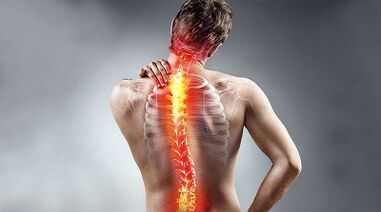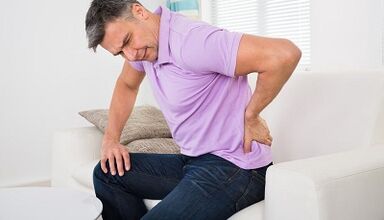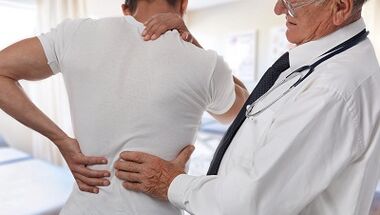
Back pain can occur at any age, but often occurs between the ages of 35 and 55.The pain in the spine is associated with our bones, muscles, discs, ligaments, tendons and nerves.
The pain in the spine may be caused by problems between the vertebrae, the discs between them, ligaments around the spine and the discs, the spinal cord and nerves, the back muscles, the abdominal and internal organs in the area of the pelvic area.Similarly, diseases of the aorta, chest tumors and inflammation of the upper back spine may be the cause of upper back pain.
Risk factors
The presence of risk factors increases the likelihood of a development state.For example, obesity significantly increases the risk of a second type of diabetes.
The following factors are associated with an increased risk of back pain.
- Office work;
- work related to constant pressure;
- Pregnancy - Pregnant women often suffer from spinal pain;
- A sedentary lifestyle;
- age;
- Frustrated;
- Obesity/overweight;
- Smoking;
- Major physical exercise;
- Heavy physical labor.
Signs and symptoms of back pain
The symptoms are the patient’s feelings, and the doctor may notice this.For example, pain is a symptom, while rash is a sign.
The main symptom of spinal pain is pain in any part of the back.Sometimes, the pain can extend to the hips, legs, or shoulders and arms.
If spinal pain is accompanied by any of the following signs, you must contact your doctor immediately:
- lose weight;
- High temperature (fever);
- After rest, back pain will not be relieved;
- Painful pain;
- Pain is lowered below the knee;
- The presence of fresh spinal injury;
- Urinary urinary incontinence (even a small part);
- Difficulty in urination - It's difficult to urinate;
- Fecal urinary incontinence - Loss of control over the defecation process;
- Numbness in the genital field;
- Anal numbness;
- Numbness in hips.

If you are one of these groups, please apply for expert advice:
- People under 22 years old are over 55 years old;
- Patients who have been taking steroids for several months;
- Cancer patients;
- Patients who have had cancer;
- Patients with low immunity.
Causes of back pain
The human spine is a complex structure composed of muscles, ligaments, tendons, intervertebral discs and bones.The intervertebral discs are located between each pair of vertebrae and function as a frictional shock absorber.Any of these ingredients can cause spinal pain.In some cases, the cause of the pain cannot be determined.
Stretch
The most common causes of spinal pain are:
- stretched muscles;
- stretch ligament;
- Lifting heavy objects in the wrong posture;
- Lifting an object that is too heavy;
- The result of sharp and awkward movement;
- Muscle spasms.
Structural issues
The following structural problems can cause spinal pain:
- Principles of intervertebral disc.The cracking of the disk shell causes the expansion of its internal content to expand outwardly.This can lead to nerve clamping, resulting in pain.
- Hernia of intervertebral disc- The internal contents of large and small disks are stabbed;
- Sciatica- Acute and shooting pain, radiating to the back of the hips and legs, caused by a protrusion or hernia of the intervertebral disc, compressing the nerves;
- arthritis- Patients with osteoarthritis usually experience joint problems in the thigh, lumbar spine, knee and hand.In some cases, stenosis of the spinal canal may occur due to the narrowing of the space around the spinal cord.
- ridge- If the spine is curved in an unusual way, the patient is more likely to suffer from spinal pain.An example of abnormal bending is scoliosis, where the spine is curved to the side.
- Osteoporosis- Bones, including vertebrae, become fragile and porous, resulting in increased vulnerability.

Here are some other causes of spinal pain:
- Horsetail syndrome- A ponytail is a bunch of nerve roots into which the spinal cord is branched.People with tail equine syndrome will feel pain in their lumbar spine and hips.The sensitivity of the hips, genitals, and thighs may also be lost.Sometimes people with equine syndrome suffer from urine and/or feces;
- Spine cancer- Tumors located in the spine squeeze the nerves, causing pain;
- Spine infection- If the patient has high body temperature and has painful hot areas on the back, it may indicate an infection in the spine;
- Other infections- Inflammation of female pelvic organs and infections of the bladder and kidneys can also cause back pain;
- Sleep disorders- Patients with sleep disorders are often associated with the general population on the spine;
- Herpes zoster- Infections that may affect the nerves;
- Inappropriate mattress- If the mattress does not support certain parts of the body and does not ensure a uniform position on the back, there is a risk of spinal pain.
Similarly, the cause of spinal pain may be certain exercises or body positions, such as prolonged driving, coughing, etc.
What to do when you have a back injury
If you experience pain for several days on your spine, here are tips that will help you relieve pain and discomfort and speed recovery:

- Stay active as much as possible;
- If necessary, use -counter pain medication;
- Use hot and cold compression.A bottle of hot water and a bag of frozen vegetables will be made.
Although it is difficult to stay optimistic when you suffer, don't lose it.This will speed up the recovery process.
Due to prolonged pain in the spine (which will not pass through within six weeks), you need to consult a doctor.Doctors will compile a medical history, conduct examinations, and guide it to other studies if necessary.If there is suspected bone system or osteoarthritis, CT (computed tomography) or MRI (magnetic resonance tomography), the doctor may prescribe a radiograph to prevent suspicion of vertebral hernia or any other problems related to soft tissue or nerves.In this case, MRI is the best choice.Doctors can also recommend that you hand over some laboratory tests or measure electrical activity (EMG) of the nerves.
After diagnosis, the doctor prescribed treatment.In most cases, there are sufficient conservative treatments that may include:
- Special exercises;
- Reflection;
- spinal extension;
- massage.
In severe cases, operational issues can be raised.The surgeon will help you choose the appropriate method and suggest possible complications.It is recommended to undergo undergraduate treatment for the spine for a period of time after the operation.Remember that spinal manipulation is very dangerous because the operating area is near the nerves.















































